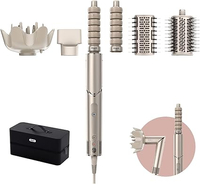Martin Lewis shares his Prime Day shopping advice – including a little-known tip for saving an extra 20%
We're shopping experts here, but savvy enough to always learn more, especially from the Money Saving Expert himself.


Here at woman&home, we have 16 staff members and a family of trusted freelancers, all experts in their field, who spend every day crafting tailored news, reviews, features and advice on everything from home decor to health – not to mention curated shopping advice.
So when an event like the Amazon Prime Day deals rolls around, we're confident that we know a thing or two about spotting the products worth investing in (and which to avoid).
However, we're not above listening to advice from other experts too, and Money Saving Expert Martin Lewis is of course a renowned expert in this field. So when we spotted his Amazon Prime Day 2025 deals analysis, we were all ears – and, not ones to gatekeep, we wanted to share our favourite tips with you, including a way to score an extra 20% off some products.
1. Track price history
Perhaps our favourite tip of Martin's is one we've also shared before, notably in our advice for Black Friday vs Cyber Monday. "As Amazon prices go up and down regularly, use a price tracker to see if it's actually a deal at all," advises Martin.
Camel Camel Camel is the first tool we always fire up when we spot a deal on Amazon. It shows the price history of an item so you can discover whether it's the cheapest it's ever been (sometimes), the cheapest it's been for a while (often) or not such a great deal after all (eg if the price has been fairly static for months, then inflated for a few weeks before the 'deal' appears – a practice that savvy shoppers have cottoned onto).
Luckily for you, when we find the holy grail of the lowest-ever price on a product we love, we never keep it to ourselves. Health editor Grace Walsh has already shared the lowest-ever price on an Oura Ring and a rare deal on an Apple Watch 10, and is keeping her eyes peeled for more.
We particularly like the way Martin has shown the cheapest-ever deals in a grid format, so here are some of our favourites:
Sign up to our free daily email for the latest royal and entertainment news, interesting opinion, expert advice on styling and beauty trends, and no-nonsense guides to the health and wellness questions you want answered.
Product | Prime Day price | Price analysis | Cheapest elsewhere |
£295 (RRP £399) | Cheapest ever – previous cheapest £299 | ||
£54.99 (RRP £149.98) | Cheapest ever – previous cheapest £64.99 | ||
£88.19 (RRP £139) | Cheapest ever – previous cheapest £94.99 | ||
£169.99 (RRP £249.99) | Cheapest ever – previous cheapest £249 |
2. Save an extra 20% at Amazon Resale
Our next favourite tip-off from Martin was that Prime members can get an extra 20% off Amazon Resale items until Friday 11 July, when the Prime Day sale ends. Previously called Amazon Warehouse, these are the products that other shoppers have returned, Amazon has thoroughly inspected and repaired if needed, and listed for resale.
It is a little trickier to navigate, but we've found the excellent deal below on a popular item, that shows it's worth the hunt.
An 'Open Box: Like New' condition Shark FlexStyle is one of many items for sale in the Amazon Resale department at the moment, listed for £202.85 but with a further 20% off for Prime Members. That makes this the cheapest way to buy this popular Dyson Airwrap alternative, ever.
Listed as 'Used - Acceptable' this is a great budget Ninja air fryer, with over 11,000 positive ratings from other happy customers.
3. Consider other retailers
"Amazon's not always cheapest for every item, even in a sale – so do your research before buying," says Martin. He recommends using 'shopbot' tools such as Google Shopping to compare prices at different retailers, as others may be price matching or even offering better savings during peak sales events.
Indeed, this is something we've seen during this Amazon Prime Day event. For example, there are plenty of Elemis skincare deals at Amazon, but some products are actually cheaper at Sephora, Look Fantastic and Boots, as we've been quick to share with you.
At woman&home we're lucky enough to have our own shopboot tool, called Hawk, which scours the web for deals on hundreds of products each day. We've included links to today's best prices on some bestsellers, below.
4. Get credit (for some Amazon members)
Martin's posts reveal a few ways that some Amazon members may be able to save a little more, or get claim voucher credits to their accounts.
"If you have an Amazon account, you may be able to get £5 off a £15 spend at Amazon," writes Martin. Check this Amazon link when logged in to see if you're eligible for the £5 credit into your account.
"Out of the 25 Amazon accounts we checked, six (24%) were eligible, so most people likely can't get this, but it's worth a quick check if you've got a planned purchase at Amazon coming up," he explains.
If you're not eligible for the £5, you may be eligible for £3 off a £10 spend – though this discount is a little more niche, as it's only for some people who live near an Amazon pickup location, but who haven't used one yet.
Visit this Amazon link to check if you're eligible. "It's best to go ASAP as it's only available until 10,000 have been claimed (or 31 December 2025 if that's later)," warns Martin. If it works, enter the code 3OFFPICKUP in the 'Your gift certificates and coupons' section at the checkout.

Ella is Managing Editor for Woman&Home online, helping the team to ensure our content is expertly written, authoritative, timely and compelling. She has 14 years of of editorial experience and a First Class Honours degree in Journalism. She regularly digs through magazine issues and digital archives to unearth content treasures in need of a good polish in order to bring readers a variety of interesting articles; helps the section editors to forward-plan features; and writes news stories and the odd buying guide or product recommendation, putting her eye for good design and photography to use. She has written and edited magazines and websites including TechRadar.com, CreativeBloq.com, Digital Camera magazine, BikeRadar.com, Mollie Makes and professional photography website www.canon-europe.com/pro.

